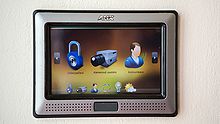Home automation or Smart Home is building automation for the home. It involves the control and automation of lighting, heating (such as smart thermostats), ventilation, air conditioning (HVAC), and security, as well as home appliances such as washer/dryers, ovens or refrigerators/freezers. Wi-Fi is often used for remote monitoring and control. Home devices, when remotely monitored and controlled via the Internet, are an important constituent of the Internet of Things. Modern systems generally consist of switches and sensors connected to a central hub sometimes called a “gateway” from which the system is controlled with a user interface that is interacted either with a wall-mounted terminal, mobile phone software, tablet computer or a web interface, often but not always via Internet cloud services.

While there are many competing vendors, there are very few worldwide accepted industry standards and the smart home space is heavily fragmented. Popular communications protocol for products include X10, Ethernet, RS-485, 6LoWPAN, Bluetooth LE (BLE), ZigBee and Z-Wave, or other proprietary protocols all of which are incompatible with each other. Manufacturers often prevent independent implementations by withholding documentation and by litigation.
The home automation market was worth US$5.77 billion in 2015, predicted to have a market value over US$10 billion by the year 2020.
Early home automation began with labor-saving machines. Self-contained electric or gas powered home appliances became viable in the 1900s with the introduction of electric power distribution and led to the introduction of washing machines (1904), water heaters (1889), refrigerators, sewing machines, dishwashers, and clothes dryers.
In 1975, the first general purpose home automation network technology, X10, was developed. It is a communication protocol for electronic devices. It primarily uses electric power transmission wiring for signalling and control, where the signals involve brief radio frequency bursts of digital data, and remains the most widely available. By 1978, X10 products included a 16 channel command console, a lamp module, and an appliance module. Soon after came the wall switch module and the first X10 timer.

According to a Research Institute, by 2012, in the United States, 1.5 million home automation systems were installed.
There are three generations of Home Automation:
- First generation: wireless technology with proxy server, e.g. Zigbee automation;
- Second generation: artificial intelligence controls electrical devices, e.g. Amazon Echo;
- Third generation: robot buddy who interacts with humans, e.g. Robot Rovio, Roomba.
Applications:
- Heating, ventilation and air conditioning (HVAC): it is possible to have remote control of all home energy monitors over the internet incorporating a simple and friendly user interface.
- Lighting control system
- Occupancy-aware control system: it is possible to sense the occupancy of the home using smart meters and environmental sensors like CO2 sensors, which can be integrated into the building automation system to trigger automatic responses for energy efficiency and building comfort applications.
- Appliance control and integration with the smart grid and a smart meter, taking advantage, for instance, of high solar panel output in the middle of the day to run washing machines.
- Security: a household security system integrated with a home automation system can provide additional services such as remote surveillance of security cameras over the Internet, or central locking of all perimeter doors and windows.
- Leak detection, smoke and CO detectors
- Indoor positioning systems
- Home automation for the elderly and disabled
In a review of home automation devices, Consumer Reports found two main concerns for consumers:
- A WiFi network connected to the internet can be vulnerable to hacking.
- Technology is still in its infancy, and consumers could invest in a system that becomes abandonware. In 2014, Google bought the company selling the Revolv Hub home automation system, integrated it with Nest and in 2016 shut down the servers Revolv Hub depended on, rendering the hardware useless.
Microsoft Research found in 2011, that home automation could involve high cost of ownership, inflexibility of interconnected devices, and poor manageability.
Historically systems have been sold as complete systems where the consumer relies on one vendor for the entire system including the hardware, the communications protocol, the central hub, and the user interface. However, there are now open source software systems which can be used with proprietary hardware.
The above mentioned are some of the key features of a Smart Home. Watch this space for the Latest Trends in Technology.
